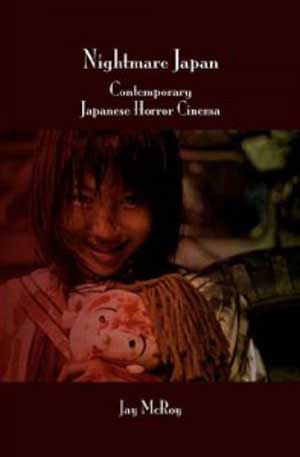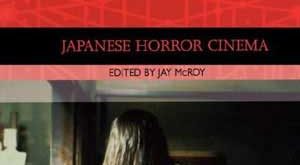 Written by Jay McRoy
Written by Jay McRoy
Published by Rodopi
Publication Date: 2007
Format: Black /White – 232 pages
Price: $67.00
Well I’m sure your first thought is the same one I had. $67? Are you kidding me? While the book is a nicely bound 6.8.75 format, the price is way beyond what a B&W book with little images should run. From my view of books that have come across my desk this book should run for about $12-$15 respectively.
Jay Mcroy, sure knows his share of Japanese horror culture and films. As he takes you into his understanding of where they came from and where it’s going.
Interestingly enough, he devotes a whole chapter to the infamous over the top Guinea pig films and a bit of there historical background. Most viewers would simply pass them off as extreme torture films without purpose or reason besides faking a snuff situation. Jay though interestingly enough sees past the eye gouging and nail ripping context to tie in the whole Japanese culture and its controversial past. As he points out, dramatic economic recovery, financial recession nd the artistic creations that emerged from the psyche of the times. Further references are made to the use of the body as a central them for
crisis. Though for all its unnerving imagery it is also celebrated into the same breath for its ability to involve the viewers into a high point of believability through usage of camera perspectives, lack of credits and cold factual information never suggesting anything but.
Much of the book digs in deep into these analytic views of the horror emergence and what makes the Japanese horror culture so unique in its direction and creation. Most notably is the degree of content, historical influences and social state of mind.
I much enjoyed the intro explanation of certain familiar images that reoccur in these films. For one the long hair and single eye which suggests beauty and the the eye association with vaginal imagery. Other contexts discuss the reoccurring “vengeful spirit” usually ion the form of a women. Then of course the early gigantic monster themes that are to have emerged from a rather nuclear conscience state in times of atomic testing and radiation aftermath.
Jay explains that a certain of level of anxiety still originates from past war crimes and atrocities committed. While this book covers the areas of horror it takes a slightly bolder step by digging into many of the cat 3 horror films. A whole chapter dedicated to films such as the “All Night Long” series and other brutal Asian releases show shows that he’s digging to find what makes these filmmakers tick and why they resort to such content.
Although its approached in a very analytical way, alot is pointed to a unique culture differences. Jaded women, war crimes, poverty, social climate and a number of historical aspects that reveals a bit a of the pain they have endured. Thing like incest , rape. and brutal body torture are common themes shown in these releases. Even with lighter horror tales such as Ring and Dark Water there is a sense of family dysfunction, lost youth, abandonment and other social issues that have plagued there culture. It’s an interesting journey that has reason for cause in which Jay does an extraordinary job at covering. The context is very philosophical so it reads a bit different than an off the shelf fan book, but at the heart Jay has put his best effort forward to give us a though background even in the face of macabre and horrific unsettling terms.
Further studies in the book go on to cover films such as Marebito, Pulse, Naked Blood, Premonition, Ichi the killer and Tesuo Iron man. A whole chapter is devoted to the new emerging trends and the issues of redundancy in the industry.
This is well thought out articulated book that I think on some levels may be above “just” asian horror film watchers. The text while articulate can be a bit overwhelming at times, though in this case Jay’s intention was not to be just another off the shelf Asian review book but something more intellectual.
Available at Rodopi
 Horror News | HNN Official Site | Horror Movies,Trailers, Reviews
Horror News | HNN Official Site | Horror Movies,Trailers, Reviews

